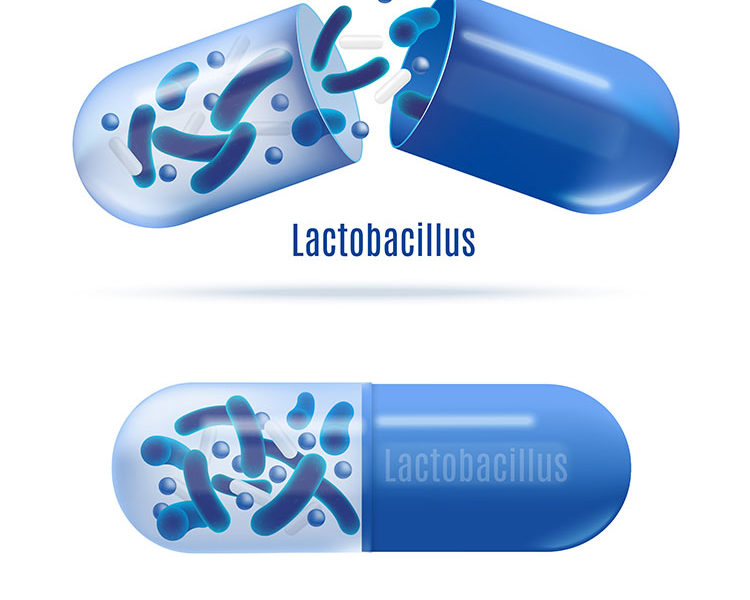
The Advantage of Multispecies Probiotics
The human intestinal system can be compared to a war zone. Deep inside our bodies, beneficial and harmful bacteria are battling it out to establish their dominance in our system. The key to good health is for the good bacteria to outnumber the bad. Fortunately, research helps us understand the science behind our intestinal battle so that we can make the right choices to give our good bacteria the competitive edge. This advantage? Probiotics. It is important to note that intestinal immune tissue constitutes nearly 80% of all the immunologically active cells in the body. Research demonstrates an important relationship between balance of microflora in the intestine and function of the immune system. This is where probiotics become important. Probiotic supplementation benefit maintenance of intestinal homeostasis, competitive exclusion of pathogens, production of antimicrobial compounds, promotion of the intestinal barrier function, immune modulation and some very promising results in the area of inflammatory bowel disease and Irritable bowel syndrome.(1,2,3)
What are probiotics?
Probiotics are the “good” or beneficial bacteria that we referred to earlier in the epic intestinal battleground. They are live bacteria and yeasts that are found naturally in the human intestine and that, when they exist in the right quantities, provide us with multiple health benefits. Different probiotic organisms have different properties. The one they have in common is the production of lactic acid, which is important in terms of inhibition of pathogenic and opportunistic organisms. Some produce bacteriocins (diverse proteins that inhibit or kill deleterious organisms), others produce catalase that acts as an antioxidant neutralizing hydrogen peroxide. The point is that a blend of probiotic species will be more effective than a single specie due to their diverse properties.
 In 2001, scientists working on a joint project between the United Nations (UN) and the World Health Organization (WHO) revised the definition of probiotics to provide a more accurate and consistent meaning across the globe. Today, their definition is widely accepted by the medical community. It states that probiotics are: “Live microorganisms which, when administered in adequate amounts, confer a health benefit on the host.” To understand the benefits of probiotics, we first need to understand more about the microorganisms themselves, the health benefit they provide and the quantities in which they become beneficial.
In 2001, scientists working on a joint project between the United Nations (UN) and the World Health Organization (WHO) revised the definition of probiotics to provide a more accurate and consistent meaning across the globe. Today, their definition is widely accepted by the medical community. It states that probiotics are: “Live microorganisms which, when administered in adequate amounts, confer a health benefit on the host.” To understand the benefits of probiotics, we first need to understand more about the microorganisms themselves, the health benefit they provide and the quantities in which they become beneficial.
Good versus bad bacteria
The good bacteria that live in our intestinal tracts offer many health benefits. They help keep bowel function regular and process indigestible fibers. They help our bodies absorb minerals such as calcium, iron and magnesium. They also produce several vitamins. Probably their most important function is to help fight off bad bacteria that can cause diarrhea and other conditions associated with poor digestive health. In a healthy situation, the gut microbiota is well balanced. Even if pathogenic bacteria are present, it will have very little chance to do any harm. In a balanced intestinal ecosystem, pathogenic bacteria cannot take hold because the environment is not conducive to either growth or adherence to the intestinal epithelium. When there is an imbalance in the microbiota, intestinal defense mechanisms cannot function sufficiently. As a result, pathogenic bacteria can multiply easily. The shift toward increased bad bacteria usually happens due to lack of sleep, poor eating habits, illness or stress. But when the balance lies in favor of the good bacteria, our bodies experience all kinds of health benefits. This includes a stronger immune system and better overall digestive health. System imbalance can also happen when naturally occurring yeast, like the opportunistic yeast, Candida albicans, grow out of control. The result of imbalanced yeast levels can manifest as a lack of energy, diarrhea or vaginal yeast infections. Yeast overgrowth typically occurs during antibiotic therapy, but other conditions can create the right environment, such as stress, difficult menses and illness. The addition of probiotics can successfully treat or prevent yeast overgrowth situation. When balance is addressed, the unhealthy yeast can no longer take hold. When we introduce more probiotics (good bacteria) into our systems, they begin to colonize and restore a healthy balance in the digestive tract. This balance is critical for the health of the entire body. Different species tend to inhabit different parts of the intestinal system, particularly the large intestine. Again, arguing in favor of using a multi-specie blend of probiotics.

The intestine and our immune health
The intestine is the human body’s most important immune function because, as mentioned previously, approximately 80 percent of the body’s immune cells are present in the intestinal mucosa. When intestinal health is out of balance, so is one’s entire immune system. The immune system controls our body’s response against food allergies, viruses, bacteria and parasites. You can understand why it’s in our own interest to keep the digestive system (our most important immune function) well-balanced and healthy. When we take probiotics as a supplement, it stimulates the immune system and help suppress the activity of harmful bacteria and yeasts. But the question is: if multi-specie probiotics are better, which bacteria should we introduce, in what combinations and in what quantities?
Probiotics exist in the body naturally
Our intestines contain roughly 100 trillion bacteria cells. These cells are not all identical and don’t all have the same purpose.
 Scientists identify each bacterium by specifying its genus, species and strain. The genus is the first word in a bacterium’s name. This indicates the broad group to which the bacteria belong. The species is the second word in the bacteria’s name. This indicates the type of bacteria. Finally, the alpha-numeric coding at the end of the name indicates the strain of the bacteria. For example, if we identify the probiotic Lactobacillus acidophilus ATCC SD-5212 then Lactobacillus is the genus, acidophilus is the species and ATCC SD-5212 is the strain. This level of classification helps the scientific community pinpoint the bacteria and its related properties. It is important for us to know which bacteria we should to introduce into our systems since each fulfills a unique purpose in our bodies. If we think back to the 100 trillion bacteria cells in our body, we are told they represent anywhere from 300 to 1,000 different bacterial species. Although there are commonalities, every human being has his or her own distinctive bacterial subgroup. We call this individual subgroup a person’s “microbial fingerprint.” The number of species, strains and genera in each person makes the microbial diversity in every individual both unique and remarkable.
Scientists identify each bacterium by specifying its genus, species and strain. The genus is the first word in a bacterium’s name. This indicates the broad group to which the bacteria belong. The species is the second word in the bacteria’s name. This indicates the type of bacteria. Finally, the alpha-numeric coding at the end of the name indicates the strain of the bacteria. For example, if we identify the probiotic Lactobacillus acidophilus ATCC SD-5212 then Lactobacillus is the genus, acidophilus is the species and ATCC SD-5212 is the strain. This level of classification helps the scientific community pinpoint the bacteria and its related properties. It is important for us to know which bacteria we should to introduce into our systems since each fulfills a unique purpose in our bodies. If we think back to the 100 trillion bacteria cells in our body, we are told they represent anywhere from 300 to 1,000 different bacterial species. Although there are commonalities, every human being has his or her own distinctive bacterial subgroup. We call this individual subgroup a person’s “microbial fingerprint.” The number of species, strains and genera in each person makes the microbial diversity in every individual both unique and remarkable.
Probiotic manufacturing
Probiotics are now produced on a massive scale due to consumer demand. Science has developed advanced fermentation technology to meet this ever increasing demand. We can produce probiotics under very specific conditions, which can then be added to nutritional products, foods and supplements to help us increase our levels of good bacteria. Probiotics are marketed by various brands and companies around the world–some more reputable than others. It is now quite common for consumers to reach for probiotics to help their bodies fight off common conditions, such as antibiotic-related diarrhea, infectious diarrhea (caused by viruses, bacteria or parasites), inflammatory bowel disease (IBD) or irritable bowel syndrome.
Why we use multispecies probiotics to address system imbalance
Multispecies probiotics are preparations that contain various probiotic strains from different genera and species. A monostrain probiotics, on the other hand, contains just one strain of bacteria. The probiotics with good clinical research behind them tend to be within the genera of Lactobacillus and Bifidobacterium. There are particular species of Bacillus and Streptococcus that are well documented as healthful probiotics, as well. But does it really matter which we use to correct an imbalance? Studies have shown that there is.
 When an imbalance occurs in our digestive systems, we need our good bacteria to address three important problem areas–all caused by the imbalance. Firstly, the good bacteria need to re-establish balance with the gut microbiota. This will in turn, inhibit the ability of the bad bacteria to multiply, called competitive inhibition. Secondly, good bacteria are needed to strengthen tight junction functionality that constitutes the barrier function of the epithelial cells of the gut wall. The barrier function helps to prevent bad bacteria from adhering to the epithelial cells to cause further harm. Thirdly, good bacteria are needed to trigger the immune system to produce immunoglobulins which has the power to neutralize bad bacteria. These three functions are performed by good bacteria. The challenge is that a blend of probiotic species is more effective at performing all three. When we administer a monostrain probiotic, it may not address all of these three problem areas as effectively as a multi-specie blend. A multispecies probiotic is more effective at resolving all three problem areas so the intestinal defense system is restored. Put simply, multispecies probiotics can immediately address multiple challenges in the intestines.
When an imbalance occurs in our digestive systems, we need our good bacteria to address three important problem areas–all caused by the imbalance. Firstly, the good bacteria need to re-establish balance with the gut microbiota. This will in turn, inhibit the ability of the bad bacteria to multiply, called competitive inhibition. Secondly, good bacteria are needed to strengthen tight junction functionality that constitutes the barrier function of the epithelial cells of the gut wall. The barrier function helps to prevent bad bacteria from adhering to the epithelial cells to cause further harm. Thirdly, good bacteria are needed to trigger the immune system to produce immunoglobulins which has the power to neutralize bad bacteria. These three functions are performed by good bacteria. The challenge is that a blend of probiotic species is more effective at performing all three. When we administer a monostrain probiotic, it may not address all of these three problem areas as effectively as a multi-specie blend. A multispecies probiotic is more effective at resolving all three problem areas so the intestinal defense system is restored. Put simply, multispecies probiotics can immediately address multiple challenges in the intestines.
Multispecies probiotics to treat diarrhea
Probiotics are a commonly accepted solution to treat or prevent different types of diarrhea, including antibiotic-associated diarrhea (AAD), traveler’s diarrhea and diarrhea caused by lactose intolerance, and others.

Antibiotic-associated diarrhea
It is believed that AAD is caused because antibiotics inhibit (bacteriostatic activity) or kill (bactericidal activity) good bacteria along with the pathogenic bacteria disturbing the balance in the intestinal microbiota. This creates an environment where opportunistic yeasts and other organisms can take over. According to a study published in the American Journal of Gastroenterology, the intake of a multispecies probiotic significantly reduced diarrhea-like bowel movements in volunteers who were taking an antibiotic. Another study published in the Journal of the American Medical Association concluded that patients on antibiotics can reduce the associated risk of diarrhea by 42 percent if they take probiotics at the same time.
Travelers diarrhea
Traveler’s diarrhea is usually caused by eating contaminated food or drinking contaminated water. Fortunately, traveler’s diarrhea usually isn’t serious — it’s just unpleasant. Multi-species probiotics can help prevent or treat this common form of diarrhea.
Lactose-induced diarrhea
It is also well-documented in research studies that the presence of lactic acid bacteria, specifically L bulgaricus and S. thermophilus, improves the digestion of lactose helping to prevent lactose-induced diarrhea. It is believed the lactic acid produced by the bacteria is useful in preventing and shortening the duration of several other types of diarrhea, too.
Acidophilus and diarrhea
The bacterium Lactobacillus acidophilus is one of the most common types of probiotics added to foods, yogurt and supplements with the specific purpose of preventing or reducing different types of diarrhea. This includes treatment for diarrhea associated with Clostridia infections or antibiotic use. Studies even show efficacy against diarrhea caused by radiotherapy in adult cancer patients.
Commercial Probiotic Products
Companies around the world are taking advantage of these and similar research outcomes to market consumers probiotic products, that may or may not have significant benefits. Activia, from Dannon, really started consumer awareness of probiotics with the introduction of their popular probiotic brand of cultured yogurts. Many other brands have followed. These probiotic brands promote their products to help maintain healthy digestive systems. Their results are mixed.
Daily intake of probiotics
More industries are tapping into the benefits of probiotics as more research becomes available. Manufacturers of nutritional products, health foods and supplements are investing a great deal to improve the health claims of their products by adding probiotics.
But it is important to remember that, to be effective, probiotic-enriched items must have a high enough level of the right types of good bacteria to allow them to grow in your intestines.
 Probiotic intake is measured in CFUs or colony-forming units. The CFU count of a probiotic is the estimated number of viable bacteria in a sample, where the word viable refers to the bacteria’s ability to multiply or colonize. For a probiotic to help your body achieve the necessary intestinal balance, you need to know you are taking in the right combination of bacteria species to help with your ailment and that the CFU is high enough to ensure the bacteria can colonize in the gut.
Probiotic intake is measured in CFUs or colony-forming units. The CFU count of a probiotic is the estimated number of viable bacteria in a sample, where the word viable refers to the bacteria’s ability to multiply or colonize. For a probiotic to help your body achieve the necessary intestinal balance, you need to know you are taking in the right combination of bacteria species to help with your ailment and that the CFU is high enough to ensure the bacteria can colonize in the gut.
The right CFU for your condition
The CFU needed for efficacy will vary depending on the condition that needs to be treated and the strain of probiotics you use. Some strains are proven to be effective at very low CFU levels. Other bacterial strains need a higher count to be effective. It’s generally accepted that if a consumer wants to use probiotics for their general health, they only need an intake of between 1 and 2 billion CFUs per day. However, consumers who want to treat a specific condition must seek out the CFU that is recommended by their health or wellness practitioner.
Time for an increased dose
It may be necessary to increase your daily dose when facing situations that cause intestinal imbalance. It is also recommended to increase the dose when you are taking an antibiotic, which naturally alters the balance of good and bad bacteria in your gut.
Use a reputable supplier
Probiotics are classified as dietary supplements and, because of this, the health or safety claims made by the manufacturer are limited by the Dietary Supplement, Health and Education Act (DSHEA)..Further, now with the Food Safety Modernization Act (FSMA) it is important that you buy your probiotic preparations from a supplier with a solid reputation for quality and reliability. , and who can verify any health benefit claims they make.
 As a retailer of health of wellness products, you are limited in what you claim by DSHEA. Essentially, you can only make a “Structure Function Claim,” not a therapeutic claim. An example of a structure function claim would be, “Nutritional support for healthy digestion and general well-being.”
As a retailer of health of wellness products, you are limited in what you claim by DSHEA. Essentially, you can only make a “Structure Function Claim,” not a therapeutic claim. An example of a structure function claim would be, “Nutritional support for healthy digestion and general well-being.”
Conclusion
There is a growing market for companies who wish to produce cultured foods, nutritional products and supplements that harness the benefits of probiotics. Clearly, different probiotic organisms have different properties. Research continues to demonstrate that a blend of probiotic species will be more effective than a single specie due to their diverse actions in the micro-ecosystem of the intestine. Their role in maintaining or restoring a healthy balance of species is effective, with few side effects making multi-specie probiotic blends ideal for intestinal issues.
Specialty Enzymes & Probiotics formulated the probiotic blends, ProbioSEB Duo™, ProbioSEB Trio™, and ProbioSEB Multi™ to complement any product looking to add probiotics to its formula.
Citations 1. Sheil, B., et al., “Probiotic effects on inflammatory bowel disease.” J Nutr, 137(3 Suppl 2): 819S-24S 2007 2. Yuan F, Ni H, Asche CV, Kim M, Walayat S, Ren J. Curr Med Res Opin. 2017 Feb 6:1-17. doi: 10.1080/03007995.2017.1292230. Epub ahead of print 3. Jadrešin O, et al. Lactobacillus Reuteri DSM 17938 in the Treatment of Functional Abdominal Pain in Children. J Pediatr Gastroenterol Nutr. 2016 Nov 30. Epub ahead of print




